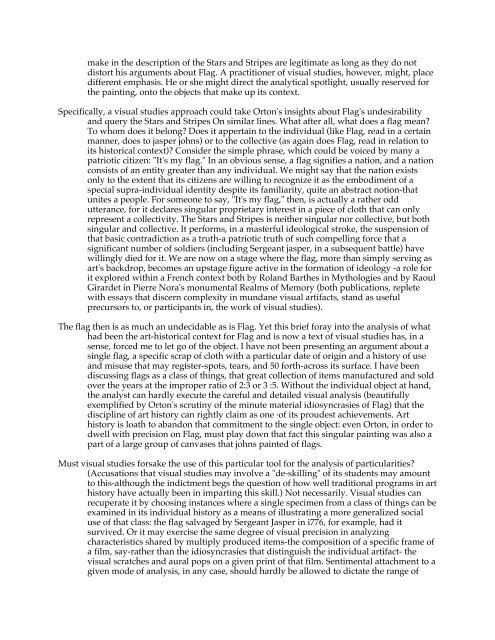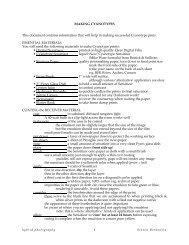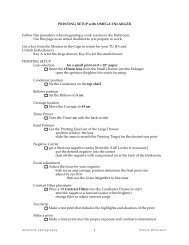Chapter Thirty Visual Culture/Visual Studies
Chapter Thirty Visual Culture/Visual Studies
Chapter Thirty Visual Culture/Visual Studies
Create successful ePaper yourself
Turn your PDF publications into a flip-book with our unique Google optimized e-Paper software.
make in the description of the Stars and Stripes are legitimate as long as they do not<br />
distort his arguments about Flag. A practitioner of visual studies, however, might, place<br />
different emphasis. He or she might direct the analytical spotlight, usually reserved for<br />
the painting, onto the objects that make up its context.<br />
Specifically, a visual studies approach could take Orton's insights about Flag's undesirability<br />
and query the Stars and Stripes On similar lines. What after all, what does a flag mean?<br />
To whom does it belong? Does it appertain to the individual (like Flag, read in a certain<br />
manner, does to jasper johns) or to the collective (as again does Flag, read in relation to<br />
its historical context)? Consider the simple phrase, which could be voiced by many a<br />
patriotic citizen: "It's my flag." In an obvious sense, a flag signifies a nation, and a nation<br />
consists of an entity greater than any individual. We might say that the nation exists<br />
only to the extent that its citizens are willing to recognize it as the embodiment of a<br />
special supra-individual identity despite its familiarity, quite an abstract notion-that<br />
unites a people. For someone to say, "It's my flag," then, is actually a rather odd<br />
utterance, for it declares singular proprietary interest in a piece of cloth that can only<br />
represent a collectivity. The Stars and Stripes is neither singular nor collective, but both<br />
singular and collective. It performs, in a masterful ideological stroke, the suspension of<br />
that basic contradiction as a truth-a patriotic truth of such compelling force that a<br />
significant number of soldiers (including Sergeant jasper, in a subsequent battle) have<br />
willingly died for it. We are now on a stage where the flag, more than simply serving as<br />
art's backdrop, becomes an upstage figure active in the formation of ideology -a role for<br />
it explored within a French context both by Roland Barthes in Mythologies and by Raoul<br />
Girardet in Pierre Nora's monumental Realms of Memory (both publications, replete<br />
with essays that discern complexity in mundane visual artifacts, stand as useful<br />
precursors to, or participants in, the work of visual studies).<br />
The flag then is as much an undecidable as is Flag. Yet this brief foray into the analysis of what<br />
had been the art-historical context for Flag and is now a text of visual studies has, in a<br />
sense, forced me to let go of the object. I have not been presenting an argument about a<br />
single flag, a specific scrap of cloth with a particular date of origin and a history of use<br />
and misuse that may register-spots, tears, and 50 forth-across its surface. I have been<br />
discussing flags as a class of things, that great collection of items manufactured and sold<br />
over the years at the improper ratio of 2:3 or 3 :5. Without the individual object at hand,<br />
the analyst can hardly execute the careful and detailed visual analysis (beautifully<br />
exemplified by Orton's scrutiny of the minute material idiosyncrasies of Flag) that the<br />
discipline of art history can rightly claim as one ·of its proudest achievements. Art<br />
history is loath to abandon that commitment to the single object: even Orton, in order to<br />
dwell with precision on Flag, must play down that fact this singular painting was also a<br />
part of a large group of canvases that johns painted of flags.<br />
Must visual studies forsake the use of this particular tool for the analysis of particularities?<br />
(Accusations that visual studies may involve a "de-skilling" of its students may amount<br />
to this-although the indictment begs the question of how well traditional programs in art<br />
history have actually been in imparting this skill.) Not necessarily. <strong>Visual</strong> studies can<br />
recuperate it by choosing instances where a single specimen from a class of things can be<br />
examined in its individual history as a means of illustrating a more generalized social<br />
use of that class: the flag salvaged by Sergeant Jasper in i776, for example, had it<br />
survived. Or it may exercise the same degree of visual precision in analyzing<br />
characteristics shared by multiply produced items-the composition of a specific frame of<br />
a film, say-rather than the idiosyncrasies that distinguish the individual artifact- the<br />
visual scratches and aural pops on a given print of that film. Sentimental attachment to a<br />
given mode of analysis, in any case, should hardly be allowed to dictate the range of







